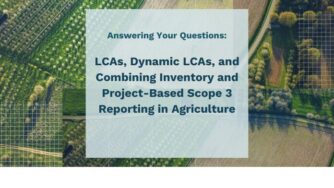More than 1,000 businesses are working with the Science-Based Targets initiative (SBTi) to reduce their carbon emissions. All over the world, companies and organizations are making commitments to goals that will help the world transition into a zero-carbon economy and fight climate change. These include Amazon, Starbucks, Apple, Home Depot, and more. Want to learn about how your business can adopt these practices?
In our most recent webinar, CIBO’s Senior Director of Product Management Chuck Alexander walked us through the definition of SBTi and the reporting that goes along with these carbon and climate commitments.
There are three different scopes for the total GHG emissions caused by an organization. Scope 1 is the direct emissions for a company. Scope 2 is the emissions caused by the electricity that the operations consume (manufacturing equipment, lights, etc.). Scopes 1 and 2 are the most straightforward ones to account for and measure. Lastly, Scope 3 is the indirect emissions from the upstream and downstream of operational activities. Upstream includes things such as sourcing materials, transportation, business travel, emissions caused by employees’ commutes, etc. Downstream is after things leave a factory such as transportation of goods.
What is a Science-Based Target?
- It is science-based (has sufficient “ambition”)
- Includes at least 95% of all Scope 1, Scope 2, and biogenic emissions.
- Includes at least ⅔ of all Scope 3 emissions, if they are 40% or more of the total.
- It has a target date 5-15 years away (*5-10 years after mid-2022). Longer-term targets are encouraged.
As of April 2021, there are 24 criteria (requirements) and 13 recommendations for SBTs.
Verification & Validation
In most cases, GHG inventories and projects should be approved by a certified third party. For example, the Carbon Disclosure Project is required for “A-List” rating and registries are required at several stages of a GHG project. There are also country-, industry-, and program-specific standards. These third-party audits of organizations’ inventories are necessary to ensure the accuracy of reported emissions. Once it is verified, Science-Based Targets also require annual public disclosure.
Watch our recording to learn about adopting SBTi, how to report on carbon and climate commitments, ways climate commitments come to life in a workplace and more.



